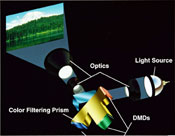
 |
 |
 |
| Single-channel Video |
The rich history of single-channel video art reaches from artists' early analog video experiments of the 1960s to new digital media works. The term "single-channel" refers to works that involve a single electronic source (such as a DVD), presented on one playback device (such as a DVD player), and exhibited using a single display mode (such as a monitor or projection). Technology-based and variable, single-channel video has generated new practices and challenges for exhibitors. Artists make multiple iterations of works that move fluidly across diverse contexts. In the four decades since video was first screened in alternative spaces, single-channel works are now presented in venues ranging from galleries, museums, cinemas, classrooms, television and the Web to devices such as cell phones and iPods. Exhibition designs range from monitors, flat screens and large-scale projections to inventive new modes for audience interaction and access. This section outlines information relating to single-channel video exhibition, including best practices; planning; rental and loan agreements; equipment and technical issues; budgets; and answers to basic but essential questions. Also included are interviews with key figures in the field, including curators, artists, and educators, as well as important articles, conference papers and case studies. |